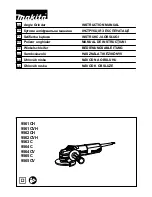
1.
Locate and remove the following parts from Sheet 1 – ‘B1’, ‘B2’, and ‘B3’, ‘B4’ and keel part ‘K2’ from Sheet
4.
2.
To get a good fit for the battery hatch is is recommended that the hatch is built ‘in-situ’ on the fuselage. To
prevent the hatch being stuck to the fuselage during construction stick clear thin sticky tape to the top of the
fuselage tops and to the faces of ‘F2-C’ and ‘F3’.
3.
Place battery hatch base ‘B4’ onto the fuselage between ‘F2-C’ and ‘F3’ with the open end facing towards
the rear. Assemble formers ‘B1’, ‘B2’ and ‘B3’ into the slots on ‘B4’ and then slot ‘K2’ onto those formers.
4.
Wick CA into the joints between the formers and the base and keel parts. Cut four
3
/
32nd
sq. stringers to
length and stick into place.
5.
The hatch is designed to be held in place using four 3mm diameter Neodymium magnets. If they are being
used then insert one magnet into the former ‘F3’ on the fuselage so that it is flush with the face of the former.
Wick CA into the hole in ‘F2-C’ behind the magnet, and stick into place. Repeat the process to stick a magnet
into former ‘F3’.
7.
Take another magnet, check that it is correctly oriented so that is attracted (and not repulsed) to the one in
‘F2-C’ and insert it into former ‘B1’ on the battery hatch so that it is flush with the surface of the former. Do the
same for ‘F3’ / ‘B3’. Check that the battery hatch fits with both magnets holding it in place. If all is okay remove
the hatch and wick CA into the holes to the rear of the magnets on ‘B1’ and ‘B3’.
8.
Stick some self-adhesive Velcro
®
type tape onto the battery tray. The other piece is attached to the battery.
9.
Cut a piece of 20mm wide Velcro
®
type battery strap to a length of 15cm and from the top pass it through an
outer slot of the battery tray, loop it round and from underneath pass it through the opposite slot.
Install Servos, Electronic Speed Controller (ESC), Receiver and Motor
1.
Mount the servos on to the servo tray from the underside of the fuselage with the servo arms fitted with
pushrod connectors pointing to the centre line of the fuselage and fix with the supplied screws. Run the servo
leads rearwards through ‘F4’.
2.
Stick the ESC with double sided servo tape to the fuselage side between formers ‘F2-C’ and ‘F3’ passing the
motor leads through the hole in the motor mount and the battery lead up through the lower slot in ‘F3’ and up
through the slot in ‘H3’ to the rear of the battery tray. Ensure that the motor leads can be easily reached at the
front to allow the motor to be connected.
3.
The motor can be installed now using the M3 screws or later after the fuselage has been covered.
4.
Cut the elevator and rudder pushrods to an initial length of 500mm. The elevator pushrod needs to be bent
to reach the elevator control horn as shown in
Fig 1
below.
5.
Insert the rudder and elevator pushrods from the rear via the slots in the fuselage feeding them through the
holes in ‘F8’ into the pushrod connectors on the servos. Lightly tighten the pushrod connector screws to hold
the pushrods in place.
6.
The receiver can be mounted now or after the fuselage is covered. The receiver can be mounted on a
fuselage side behind ‘F4’ using double-sided servo tape. Please note that the receiver should be mounted in
such a way that connecting the ‘Y’ aileron servo lead to the receiver is straight-forward.
Complete the Fuselage Build
Balsa Basics Messerschmitt Bf 109 Vintage Model Company
3



























